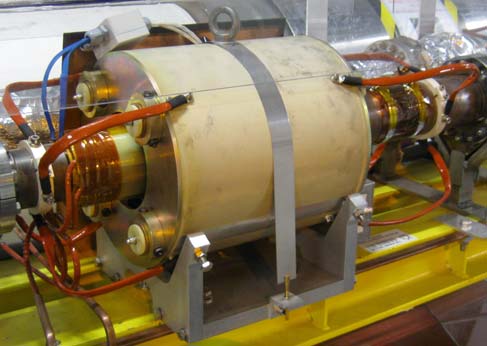Taking a closer look at LHC
Measurement of Beam Current
The beam current is the basic quantity of the beam, It is the first check of the accelerator functionality and is very important for transmission measurement and to prevent for beam losses.
Different devices are used for this goal, but the LHC circulating beam current measurement is provided by current transformers. They are based in the Measurement of the beam’s magnetic field. This kind of devices are non-destructive, they have no dependence on beam energy and they have lower detection threshold.
For LHC beam are used two DC current transformers (DCCT) and two fast beam current transformers (FBCT) per ring (so, eight transformers in total).

DC current transformers (DCCT)
In a very simple approximation we can introduce how transformers work as follows:
Beam creates, such as a current-carrying wire, a magnetic field B.

Transformer "feels" this magnetic field.

Torus guides this magnetic field which produces a secondary current Isec on the secondary winding on the torus.
The crucial idea is that the beam acts as primary winding with Nbeam =1.
So,
Ibeam/Isec= Ntorus/Nbeam ⇒ Ibeam = Ntorus · Isec
By using Ohm's Law,
V = R · Isec , so Isec = V / R
and finally,
Ibeam = Ntorus·V / R
Obviously, things are "a little bit" more complicated. For more information click here.
At full power, LHC beam current intensity is:
Ibeam = 0,58 Amperes
Considering 11245 laps we have:
0,58/11245 = 5,16·10-5 Culombs/lap
With qproton = 1,602·10-19 C
5,16·10-5 / 1,602·10-19 = 3,22·1014 protons/lap
Since there are 2808 bunches per ring, we have finally:
3,22·1014/2808 = 1,15·1011 protons / bunch
|
AUTHORS Xabier Cid Vidal, PhD in experimental Particle Physics for Santiago University (USC). Research Fellow in experimental Particle Physics at CERN from January 2013 to Decembre 2015. He was until 2022 linked to the Department of Particle Physics of the USC as a "Juan de La Cierva", "Ramon y Cajal" fellow (Spanish Postdoctoral Senior Grants), and Associate Professor. Since 2023 is Senior Lecturer in that Department.(ORCID). Ramon Cid Manzano, until his retirement in 2020 was secondary school Physics Teacher at IES de SAR (Santiago - Spain), and part-time Lecturer (Profesor Asociado) in Faculty of Education at the University of Santiago (Spain). He has a Degree in Physics and a Degree in Chemistry, and he is PhD for Santiago University (USC) (ORCID). |
CERN CERN Experimental Physics Department CERN and the Environment |
LHC |
IMPORTANT NOTICE
For the bibliography used when writing this Section please go to the References Section
© Xabier Cid Vidal & Ramon Cid - rcid@lhc-closer.es | SANTIAGO (SPAIN) |



